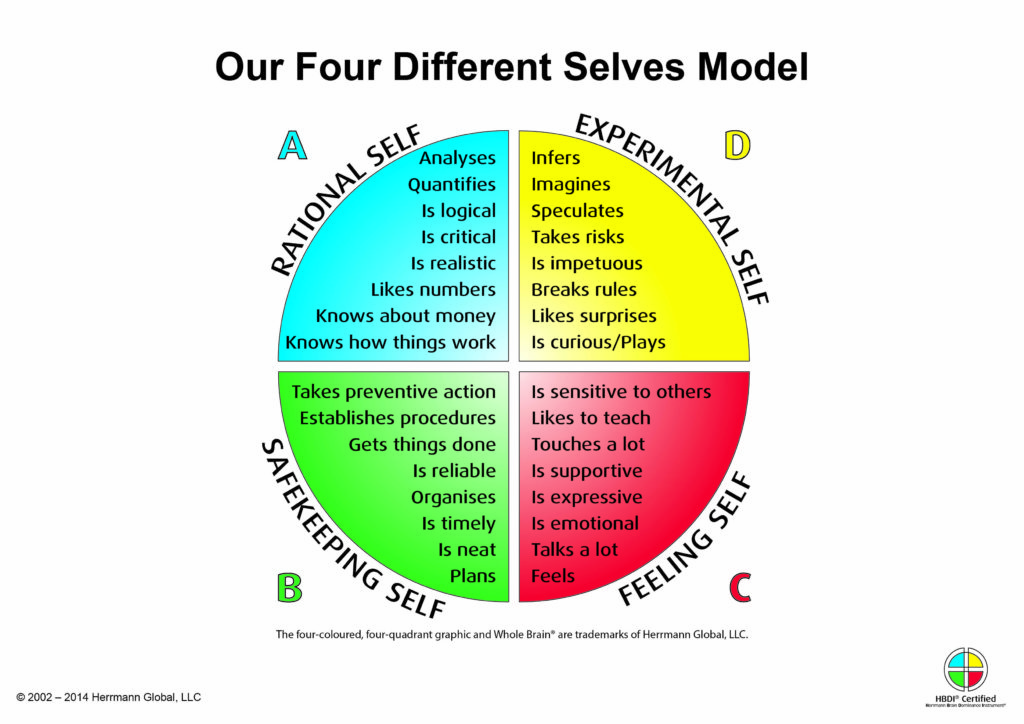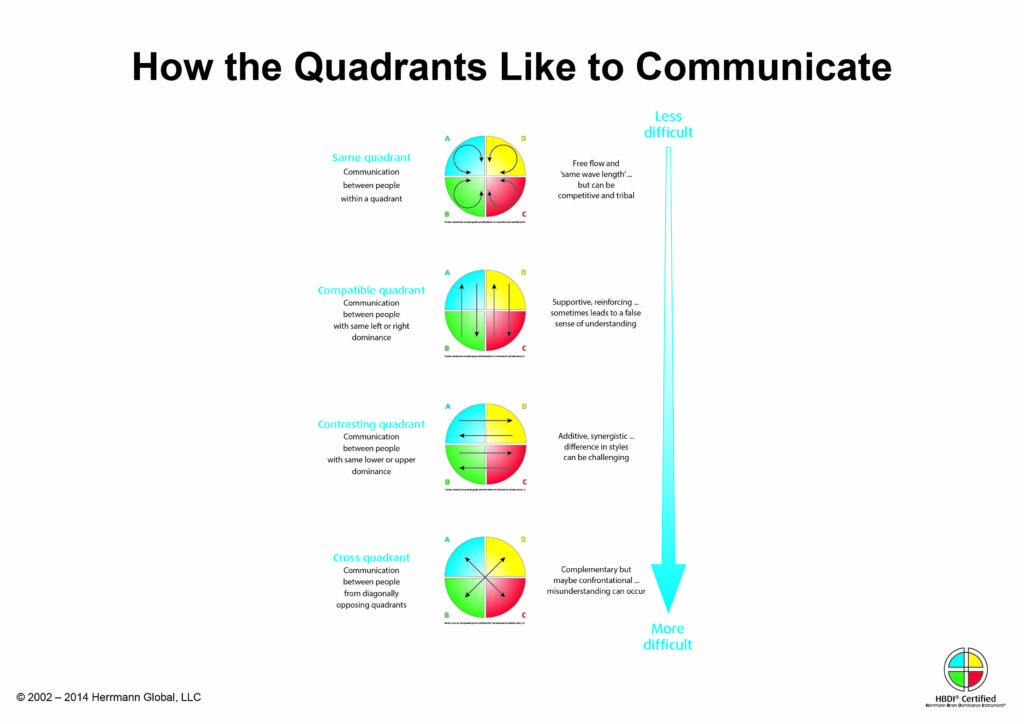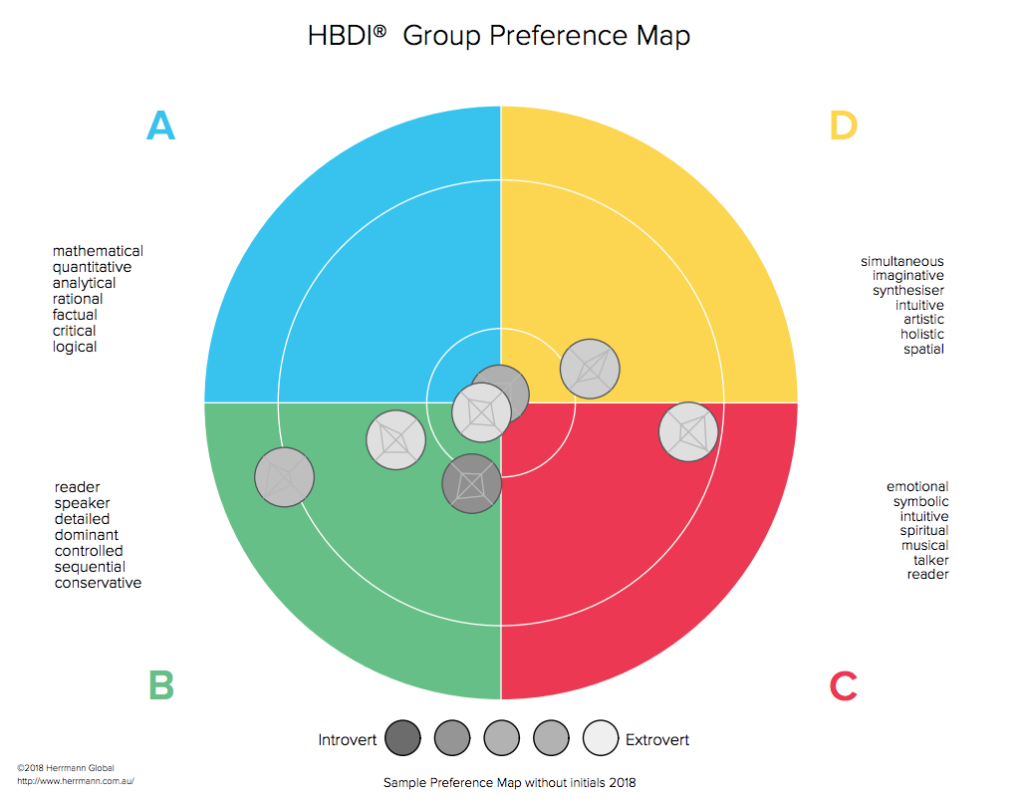How often have you left a discussion frustrated or confused at what others have said or how they have acted? Or maybe you have failed to get your message across to others, and you are flabbergasted they “just don’t get it” or maybe they “just don’t understand me”.
There was no “meeting of the minds”.
Conversely, you might have experienced great discussions and meetings where you were all “on the same page” or “talking the same language”.
All these familiar sayings are shorthand for explaining the phenomenon when we connect or can’t connect our thinking with another person. Our thinking preferences determine our “go-to” patterns for perceiving the world.
“Nothing is as it seems, but something is everything it is made out to be.”
Carroll Bryant
Our language and actions communicate our thinking. We believe we understand what others are thinking through our perception of and processing of our senses of hearing, sight, smell, and touch. The Herrmann Whole Brain Thinking® Model is a way to visualise and understand the way we think.

When we transmit information to someone in a format they are not ready or willing to receive, it will likely be filtered out, blocked or misinterpreted. When we transmit information to someone in a format that they are open to receive, it is more likely they will understand what it is we are trying to convey.
In a recent coaching session, we were talking about connecting and networking and seeking potential mentors. I asked the client to tell me how a certain executive spoke, acted and about their environment (how they dressed, their accessories, set up their desk, decorated their office etc). It turned out they were very expressive, supportive and physically expressed themselves through touch. He came to the conclusion that the executive probably tended to Quadrant C in the Whole Brain Model, the red “feeling” quadrant. Whereas, he was more likely to view the world and express himself through the Blue A “rational” and Green B “safekeeping/organised” quadrants. Through a series of questions on how he should communicate with this exec it quickly became obvious that approaching them with talk of facts, figures or process or plans would not really engage their attention. My client needed to adopt a communication strategy that would work at the Executives level, a more personal, relationship-oriented emotional connection. This was more likely to build rapport and strengthen their connection and mutual understanding.

Although the setup is stereotyping male & female communication styles, one of my favourite videos I use to explain miscommunication is “It’s Not About The Nail” by Jason Headley. The thumbnail and title give away the punchline, but it’s still a good laugh and insightful on how we need to modify our communication style occasionally to be heard.
“Words are the clothes thoughts wear.”
Samuel Beckett
People with diametrically opposed thinking preferences, like blue vs red or yellow vs green quadrants, can complement each others thinking. However, it is more difficult to communicate and misunderstandings and frustrations can arise.
Consider these examples. A tribe of yellow “ideas people” hijacking an orderly green person’s meeting agenda to develop an execution plan, by brainstorming new product ideas and not setting any concrete actions. Or a numbers-oriented blue quadrant CFO being frustrated by a red quadrant CMO taking the first 10 minutes of a budgeting meeting talking about their kids’ touching ballet performance on the weekend.

We all have access to all four Thinking quadrants to varying degrees. In any one meeting, you might have to cater to all four thinking styles.
Some tips for effective communication:
- Being aware of each quadrant’s listening requirements, observe reactions, listen carefully and determine preferences
- Become skilled in delivering your message in different ways
- Cater to a diverse set of thinkers by reframing your message
- Prepare or focus your audience if you will be using only one mode, eg “Today we will just be brainstorming, no planning or judgment” or “Today we will just be just reviewing progress on existing tasks, we can discuss new ideas tomorrow”

It pays for your team and colleagues to understand each you and each others thinking preferences. A Whole Brain group/team preference map can reveal those “ah-ha!” insights as to how individuals and a team as a whole may prefer to interact.
Darren Sandford is Managing Director of Darren Sandford Consulting and Coaching. Darren is a qualified coach and certified Herrmann Whole Brain Thinking® Practitioner. With extensive experience in management, IT, banking, finance, creative photography and filmmaking, he is a qualified trainer and assessor, facilitator, trainer and a business and personal coach. He works with organisations and individuals to enable them to unlock their potential and achieve results they hadn’t thought possible.

